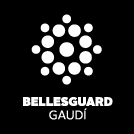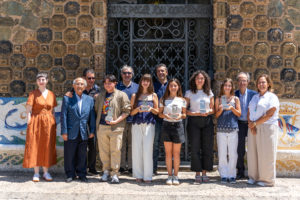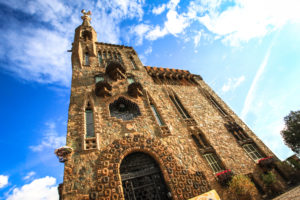By: Ferran Garcés
Soon we will open the doors to EAT GAUDI. Remember: the weekend of June 7, 8 and 9, 2024. A weekend in which we will be open morning and afternoon. EAT GAUDI is the only gastronomic market that is organized in a work by Antoni Gaudí. For more information, and to make your reservations, consult the market’s website: EAT GAUDi.
For the time being, to get you started, we now anticipate a recipe inspired by the ancient castle of Bellesguard, whose history was so well shaped by both Gaudí and his assistant Domènech Sugrañes. A dish to make mouth and memory. We hope you like it. Bon Appetit!
HAKE IN ROGER DE LLÚRIA
- Ingredients for four people
- 1 log of pike
- 1 onion
- 1 grain of garlic
- Sal
- Olive oil
- Potatoes? Peppers? Tomatoes?…
The inspiration for today’s dish is the same that was used to decorate the mosaic at the entrance to Torre Bellesguard. It is a well-known phrase of Roger de Llúria, the best admiral of the Royal Navy at the time of Peter III the Great, King of Aragon and Count of Barcelona, in the 13th century. The phrase is usually quoted in a short version, such as “That from now on there will be no fish that dares to take out its tail if it does not have tied the ensign with the four bars of our lord king of Aragon “. For the full version, follow the footnote (1)

As a tribute to such a great event, our proposal is to recreate a fish with four bars. It has to be a typical Mediterranean fish, like hake, but of course it can be any other fish you like better.
To start, heat the oven to about 200º. Next, arrange the trunk of the chosen fish, properly washed, on a tray and, to taste, add oil, salt, onion and garlic. Another option, logically, is to cook it on the grill or boiled. Well, that’s it, the easy part. Now we continue with the most complicated part, that of the ingredients with a question mark. Potatoes? Peppers? Tomatoes?…
The part with history…
To evoke the four bars mentioned by Roger de Llúria, it seems that it would only be necessary to spread four strips of red pepper on top of the fish, and, to give it a little more flavor and substance, add some potatoes and tomatoes. However, Roger de Lluría died in 1305, that is to say, almost two hundred years before Columbus arrived in America, the continent where peppers, potatoes and tomatoes come from.
What can we put on our plate if we want to be rigorous with history? To find the solution, we will look for advice in El Llibre de Sent Soví, the first known recipe book of Catalan cuisine and one of the first in all of Europe. Written by an anonymous author in 1324, it coincides, more or less at the time of Roger de Llúria (1245-1305). Thanks to him, we know that, at that time, neither cod nor herring were consumed, because they are Atlantic fish. Instead, if you ate shark, dolphin or sturgeon. In fact, the Torre Bellesguard mosaic reminds one of these animals (link). Now that you know, will you trade pike for one of them?
Be that as it may, we still need to resolve the issue of the four bars. What can we put in place of red peppers? Well, they could be pieces of strawberry, raspberry or pomegranate. And to replace potatoes and tomatoes? Let’s look again in the pantry of El Llibre de Sent Soví. In the vegetable section, we find lettuce, endive, watercress, endives, onions, garlic, aubergines, leeks, pumpkins and carrots, a vegetable, by the way, that was purple or yellow back then. The orange color is later ( 2) Lemons and oranges were also slightly different because of their taste, much more sour.

Among the legumes, beans, peas and chickpeas are mentioned. On the other hand, we have rice, flour, semolina and barley. The basis of food, according to this book, was bread, eggs and goat and sheep cheeses. Sauces take up a considerable part of the book and their main base is onion and almond. The stir-fry is made without tomato. We can also find in the pantry, mushrooms, dates, figs and honey, as well as spices. The most recommended are saffron, black pepper and ginger, which was very fashionable throughout Europe in the Middle Ages, although almost nothing is used this year. There are two other products that may surprise us because of their popularity at the time, almond milk and rose water.
Remember it’s Easter
Are we done with all the nuances? Well, cooking is not all about ingredients and cooking methods. Table manners also matter. For example, in Roger de Llúria’s time, the liturgy was of great importance in everyday life, including the kitchen. Taken from religious conventions, we consumers are forced to change the ingredients, depending on the days. Now that we are in Easter, to accompany the Lluç a la Roger de Llúria, for example, then they would have served a bowl of legumes instead of a chicken or meat broth.
To learn more about both recipes and etiquette, we recommend another book: How to drink and eat well, by Francesc Eiximenis, the most influential author in the court of Martí I l’Humà, the king who built the original castle of Bellesguard and which, in its time, was known as “L’Ecclesiastic”, for its great fondness for religiosity. A factor to consider because, in reality, how to make good use of drinking and eating is part of a larger work entitled, Lo Crestià, written with the intention of being the compendium of everything a good should know Christian at that time.
Your turn, what will you do?
Well, you’ve seen that you have options. The most important thing, of course, is what you decide. The result will be, in any case, a combination of flavors, as you have seen, well filled with history. Which option will you choose? Will you be more cautious, and serve the pike with foods from The Book of Saint Soví, or more daring, and commit a little license, adding peppers, potatoes and tomatoes?
Please share your recipe with us. We will be delighted to share it in our networks. Come, we await your pike at Roger de Llúria! Pike, or other Mediterranean fish. Come, let’s cook!
Notes
(1) The original sentence is actually a bit longer. We find it in chapter CLXVI of the Chronicle of Bernat Descolot (chap. CLXVI), and it says thus:
“No one thinks that a galley or any other old dog can go on the sea, except under the guidance of the king of Arago; not yet only a galley, nor a wood, but he does not believe that no fish can rise to the sea, if they have heard o sign of the king of Arago in the coha, to show guidance of that noble lord, the king of Arago and Cecilia”
More information: Garcés, Ferran (24/03/2021), “Roger de Llúria. Expansion through the Mediterranean“, Torre Bellesguard blog. link
(2) Martínez, Natalia (09/02/2021), “This is the true origin of the orange color of carrots”, La Vanguardia, Link




